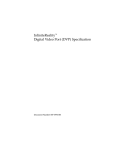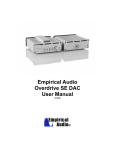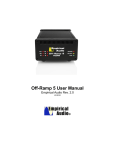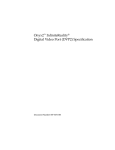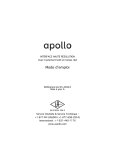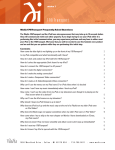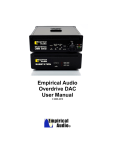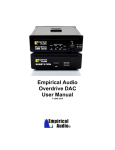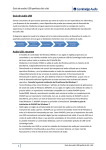Download Empirical Audio Pace-Car USB User manual
Transcript
Pace-Car USB User Manual Empirical Audio Rev. 1.0 © 2010 Pace-Car USB User Manual Empirical Audio Rev. 1.0 1. Function/Technology The Pace-Car USB is a versatile hi-res compatible USB interface combined with a reclocker that can be used with an array of devices including various WiFi devices and some CD transports. The object of the Pace-Car USB is to reduce jitter in the digital data stream of streaming audio. Digital data goes into the Pace-Car USB and digital data comes out, only with lower jitter. The Pace-Car USB incorporates our best low-jitter technology and includes an array of technical advantages over other devices on the market, including: • • • • • • • • • Galvanic isolation of all inputs to outputs Async USB, so expensive USB cable is not necessary External DC power source, allowing battery power Separate input and output power regulation High-quality discrete voltage regulation Precision impedance-matched high slew-rate S/PDIF output Optimum clocking for best 24/192 performance I2S output interface for lowest jitter to Empirical Audio DACs Modular design to allow for clock, power and USB improvements and upgrades These technical advantages allow the Pace-Car USB to be a world-class digital source, leaving even the most expensive CD transports and USB converters in the dust. The sound of the Pace-Care USB is unlike any other digital source. The clarity and imaging is unsurpassed, allowing you to “see” into the soundstage more than ever before. Width and depth are improved significantly. It is a totally immersive experience, the way that music playback should be. More like analog, only better. 1.1. What is jitter? Jitter is the number one problem limiting the performance of digital audio. Jitter creates an unnatural, harsh and sibilant sound that is pervasive in digital audio. Jitter causes listening fatigue with both CD players and computer audio devices. It’s only in the last three years that the audio industry has become sensitive to jitter and started actively addressing this. The sound of jitter is like looking through a window with a film on it. When jitter is reduced, it is like cleaning the window and finally seeing the scenery outside with crystal clarity and vividness. Jitter is the inaccuracy in the timing of the digital data. It is not data errors, it is inaccuracies in the timing of the presentation of the data to the D/A converter. This is different than sending digital data to a printer for instance, or even a hard-disk. These data transfers are not “real-time”. Streaming audio data from a CD transport or a computer source is real-time because the D/A converter creates a real-time analog signal from the data each time a new data word is presented. If the timing of the presentation of each word is inaccurate, this causes frequency modulation distortion. There is nothing that can be done about the samples in the recording and the clock that was used to make those samples, but playback jitter can be minimized. This is the role of the Pace-Car USB. The Pace-Car USB virtually eliminates the sibilance and harshness due to jitter, making your digital playback closer to analog. The Pace-Car USB is a truly unique and remarkable product. Once jitter is minimized, the clarity, image focus and dynamics are improved significantly. Even bass-tightness improves. Recordings of rain, thunderstorms, violins, cellos, bongos and timpani are finally lifelike. 1.2. Theory of Operation The Pace-Car USB is a reclocker, meaning that the timing of the data flow into the device is retimed using an internal clock. The Pace-Car USB reclocker inserts between your source device or computer and your DAC. The Pace-Car USB buffers the music data stream in a memory and then reclocks it out with an ultra-low jitter clock. The data is not modified an any way, it just passes through. There is a small amount of data that is always stored in the memory, but it will not cause any audible delay in the music start-up. The only cable that is critical to performance is the cable between the Pace-Car USB and your DAC. This should be a high-quality S/PDIF coax, AES/EBU or I2S cable to minimize jitter. 1.3. Modes of Operation The Pace-Car USB can be used in a variety of different ways, each achieving identical sound quality: 1. 2. 3. 4. USB interface from a PC or Mac computer Mode 1 – Word-Clock driving a stock external source device Mode 2 – Master-Clock driving a modded external source device Mode 3 – Pace-Car USB clocks are tuned to a stock external source device All sources use the clocks inside the Pace-Car USB and the data-stream passes through the Pace-Car USB. All modes can be used in the same Pace-Car USB, with some Mode 3 sample-rate limitations. The Pace-Car USB uses two separate clocks to support all sample-rates. Both standard clocks are present in the stock product. One clock is used for 44.1, 88.2 and 176.4. A second clock is used for 96 and 192. 48 can be optionally added, but may slightly affect the quality of 192. Upgrades of one or two Superclocks or one or two Ultraclocks can replace the standard clocks for even better jitter performance. 1.3.1. USB: The USB interface is asynchronous, meaning that it does not rely on the timing of the clock in the computer. This enables great results with inexpensive USB cables and computers. A USB 2.0 port on the computer is recommended. On playback, the Pace-Car USB automatically selects the correct clock for each sample rate. The USB module is isolated from the Pace-Car USB power and powered from the USB cable. With USB, you basically connect it and forget it. The Sample-Rate switch on the back-panel has no effect when in USB mode. 1.3.2. Mode 1: For Mode 1, the source device must have a Word-Clock input, such as some high-end transports like the Marantz SA-11S2, some Firewire devices such as the Fireface400, PCI cards such as the Lynx AES16 or the Transporter. WordClock is a low frequency clock that matches the sample-rate, such as 44.1 kHz. A Word-Clock cable is connected between the Pace-Car USB and the source device. The Word-Clock cable is ordered separately and usually terminates into a 50 ohm BNC male connector. This BNC connects Word-Clock to your source device. The Word-Clock output can be set for 5V or 3.3V logic levels depending on the source device. This is done at the time of ordering. The customer also provides two digital cables, one inexpensive cable for input to the Pace-Car USB and a high-quality cable for output to the DAC. These cables route the digital data in and out of the Pace-Car USB. The Word-Clock output on the Pace-Car USB changes automatically to match the sample-rate of the incoming data-stream within a few clock cycles. The source device must also respond fairly quickly to changes in the Word-Clock frequency. If this change takes 30 seconds or more, it is likely that the Pace-Car USB will overrrun or underrun its buffer. If devices have this delay problem, the Pace-Car USB can optionally output a fixed Word-Clock frequency. This is a custom order. The switch on the backpanel must be in the correct position to match the samplerate of the incoming data-stream. The two positions are: 44/1/88.2/176 and 96/192. Optionally, the second position can be 48/96/192. 1.3.3. Mode 2: For Mode 2, the source device must have a Slave-Clock input. This can be added to Sonos, Squeezebox, Duet, Tascam US-144, and other devices. The customer must order a modification to add the Slave-Clock input to their source device. Once this Slave-Clock input is added, the device will not operate without the Pace-Car USB attached. A master/slave-clock cable is connected between the Pace-Car USB and the source device. This must be purchased separately. The customer must provide an inexpensive data cable from the source device to Pace-Car USB and a high-quality cable from the Pace-Car USB to the DAC. These cables route the digital data in and out of the Pace-Car USB. Very Important In Mode 2, the Pace-Car USB must be powered-on first and the master/ slave-clock cable connected and then power-on the source device. The switch on the backpanel must be in the correct position to match the samplerate of the incoming data-stream. The two positions are: 44/1/88.2/176 and 96/192. Optionally, the second position can be 48/96/192. 1.3.4. Mode 3: For Mode 3, the Pace-Car 2 is tuned to the source computer or stock device and tracks the rate of the incoming digital stream. Such devices include: Mac Mini, Macbook, AirPort Express, iPod, Wadia iTransport and Apple TV. The customer must ship the source device to Empirical Audio so that we can tune the Pace-Car USB. This requires one day. No mods are required to the source device. An adapter Toslink cable is included for most devices. There is an additional cost for tuning and only Superclock4 can be used. With a tuned Superclock4, the Pace-Car USB can still be used all other Modes, but may be limited in Sample-Rate. The only cable that must be high-quality is the one used from the Pace-Car to the DAC. The customer must provide an inexpensive data cable from the source device to Pace-Car USB and a high-quality cable from the Pace-Car USB to the DAC. These cables route the digital data in and out of the Pace-Car USB. The switch on the backpanel must be in the correct position to match the samplerate of the incoming data-stream. The two positions are: 44/1/88.2/176 and 96/192. Optionally, the second position can be 48/96/192. 2. Front-Panel: 2.1.1. Input Select Switch Input selector for S/PDIF coax in, Toslink in and USB in. This can be changed on the fly to select various sources. 2.1.2. Power LED Illuminated when there is DC power to the Pace-Car USB. 2.1.3. FIFO Overrun indicator Illuminated when the internal memory has overflowed. For this to occur, the data input rate must be higher than the data output rate. Check rear-panel SampleRate switch for correct position in Modes 1,2 and 3. Not illuminated in normal operation. 2.1.4. FIFO Empty Indicator Illuminated when the internal memory is empty. Normally on at power-on with no data sources, or if the data input rate is lower than data output rate. Check rearpanel Sample-Rate switch for correct position in Modes 1,2 and 3. Not illuminated in normal operation. 2.1.5. Sample-Rate Indicators Only one LED is illuminated at a time. Indicates the Sample-Rate of the incoming data-stream that is selected by the Input Select Switch. 3. Back-Panel 3.1. 12VDC input This is the power input for the Pace-Car USB. It powers everything, except the USB interface, which is powered from the USB cable. The power from this goes directly to the standard clocks, Superclocks or Ultraclocks, so the quality of this power is critical. Upgrades here make an immediate difference in jitter. Average power consumption is up to 500ma, depending on clock options, but much higher transient currents are possible. The standard AC adapter included with the Pace-Car USB supplies 5.5 Amps @ 12VDC. The connector is center positive, 2.5mm and protected from reverse voltage. To power-on the Pace-Car USB, plug in the AC adapter and then connect the DC power cable to the Pace-Car USB. The included AC adapter grounds the chassis of the PaceCar USB to earth ground. Any other AC supplies used with the Pace-Car USB should also have the ring or minus of the connector tied to earth ground and AC ground. 3.2. S/PDIF Coax input The S/PDIF input is for use in Modes 1,2 or 3. It should be connected to the source device S/PDIF coax output using a 75 ohm digital coax cable. This input supports only PCM data, not AC3 surround. All sample-rates are supported, but must be selected in two groups using the Sample-Rate switch on the back-panel. The S/PDIF input is isolated, so the ground return is not connected to the chassis ground of the Pace-Car USB. The input is terminated in 75 ohms characteristic impedance. 3.3. Toslink Input The Toslink input (optical) is for use in Modes 1,2 or 3. It should be connected to the source device Toslink output. This supports only PCM data, not AC3 surround. All sample-rates are supported, but must be selected in two groups using the Sample-Rate switch on the back-panel. The Toslink has a door on it that flips up inside when you insert the optical cable end. Some cable ends are too large and can damage the door, so if it is difficult to insert, don’t force it. Instead, use a small knife to trim the ridges on the cable connector a bit to prevent damage to the door when mating. 3.4. USB input The USB input connects to the source computer, either a PC or a Mac. The USB cable can be as long as 5 meters and the quality is not important. The 5V power in the cable is used to power the USB interface in the Pace-Car USB. The USB port on the computer should preferably be 2.0 compliant. It is recommended that you disconnect the USB cable only after stopping music playing on the computer. To prevent application and system crashes, it is best to close the music player application, such as iTunes or Foobar BEFORE disconnecting the USB cable. Make sure that you load the USB driver into the computer before connecting the USB cable for the first time. 3.5. S/PDIF Coax Output The S/PDIF coax output (optionally AES/EBU output) is the primary output that will connect to most DACs. The return signal on this connector is tied to earth ground and chassis ground, so the ground used for the Pace-Car USB AC power adapter should be the same ground used for the DAC. Same AC circuit and phase also. The output impedance is 75 ohms if the connector is S/PDIF and 110 ohms if AES/EBU. The cable that connects from this connector to your DAC should preferably be of highest quality and match the impedance, 75 ohms for S/PDIF or 110 ohms for AES/EBU. The RCA jack is made of high-quality direct-gold plated copper with Teflon insulator, so it is better than most BNC connectors. Optionally, a Canare BNC connector can be supplied here, which is also excellent quality. The cable attached to this connector should be at least 1.0m in length, but minimize the length beyond that. 1.5m is usually perfect and will work best with other gear. 3.6. I2S output I2S is a more direct D/A interface than S/PDIF. It was developed by Philips when Philips and Sony created the CD format and the S/PDIF interface specification. I2S is a three or four-signal interface that includes clocks. All four signals are provided at 3.3V logic levels at the Pace-Car USB output, but 5V logic levels are available optionally. I2S is the native interface for most D/A chips. Therefore if one can drive I2S directly and avoid S/ PDIF translation, there is the opportunity to reduce jitter even more. Empirical Audio standard I2S interface uses 4 signals and 4 returns and the RJ-45 connector. It is compatible with I2S on several other manufacturers DACs, including Stello, Perpetual Technologies and Northstar, as well as our own Overdrive DAC. Other manufacturers DACs require an adapter cable to make the connection since they don’t all use RJ-45 and the pinouts are not compatible. Most of the other manufacturers DACs also require the 5V logic level option. Make sure the I2S connectors are mated at both ends of the cable before powering-on either the Pace-Car USB or the DAC. Likewise, power both down before disconnecting the I2S cable. 3.7. Sample-Rate Selector Switch This two-way toggle switch selects between two groups of sample-rates when the PaceCar USB is used in Modes 1, 2 or 3. It has no effect when the USB input is selected. It is possible to customize these groups for additional fee, such as combining 44.1/96/192 into one group. 3.8. Word-Clock output Word-Clock is output on a SMA connector with 5V logic levels and 50 ohms output impedance. Other configurations are optional, including low-impedance, 75 ohms impedance or 3.3V logic levels. Provides a clock signal equal in frequency to the sample-rate of the incoming data-stream to a source device, such as 44.1kHz. Turns off if there is no incoming signal on the selected input. Consult with Empirical Audio to be sure you have the right configuration for your source device. This output is used in Mode 1 operation. 3.9. Master Clock Output A A high-frequency clock output for Mode 2 operation on a SMA connector. This is a freerunning clock at 11.2896MHz, with 5V logic levels and 50 ohms output impedance. This can be changed optionally by Empirical Audio to 22.5792MHz or 45.1584MHz. A Master clock cable must be connected from this connector to the source device to operate in Mode 2. 3.10.Master Clock Output B A high-frequency clock output for Mode 2 operation on a SMA connector. This is a freerunning clock at 24.576MHz, with 5V logic levels and 50 ohms output impedance. This can be changed optionally by Empirical Audio to 49.152MHz. A Master clock cable must be connected from this connector to the source device to operate in Mode 2. 4. Software Software drivers must be loaded to support the USB interface for both PC and Mac before connecting the USB cable. For operation on a PC, Kernel Streaming is recommended to bypass Kmixer on XP machines and WASAPI on Vista and Win7 machines. 4.1. USB Drivers Drivers are located on the included CDROM disk. Load the appropriate driver for your machine and OS and execute it on the computer before powering the Pace-Car USB or connecting the USB cable to the computer for the first time. 4.2. Player Software For PC, the latest version of Foobar2000 is recommended as a player. Install this first. For XP, a Kernel Streaming plug-in is included on the CDROM. Copy this plug-in to the “components” folder under C:\Program Files\Foobar2000. Then start Foobar2000 and select the File pull-down. Then select Preferences. In the Preferences window, go to Playback – Output – select HiFace Kernel Streaming. With XP, the sample-rate will be selected automatically. With Vista and Win7, you must change the sample-rate manually on the computer in control-panel/sounds and audio devices/advanced. For Mac, we recommend iTunes with software add-ons such as Amarra or Pure Vinyl to improve audio quality. If you use iTunes alone, then select HiFace in Preferences/Audio and use Utilities/Midi options to select the sample-rate. Using iTunes alone requires you to manually select the sample-rate each time you change to playback of a different sample-rate. 5. Specifications Inputs 1. USB 2. S/PDIF coax 3. Toslink 4. 12VDC AC adapter Outputs 1. S/PDIF coax or AES/EBU 2. I2S on RJ-45, Empirical Audio standard (3.3V or optional 5V) 3. Word-Clock output 4. Master Clock output for 44.1 5. Master Clock output for 96 Controls 1. Front Panel input select switch for USB, S/PDIF or Toslink 2. Rear-panel select switch for 44.1/88.2/176.4 or 96/192 Jitter specs (cycle to cycle, standard clock): S/PDIF coax output - <1nsec total P-P jitter, <34psec P-P jitter below 1MHz Master Clock outputs - <250psec total P-P jitter, <27psec P-P jitter below 1MHz Compatibility The Pace-Car 2 is designed to work with all DACs and SS receivers/processors. The I2S output can be converted to 5V optionally for DACs such as Stello or Northstar. Sample-rates supported by USB/Modes 1 and 2: 44.1kHz, 88.2kHz, 96kHz, 176.4kHz, 192kHz Sample-rates supported in Mode 3: 44.1kHz, 88.2kHz, 96kHz Included 1. Pace-Car USB with 2 standard clocks (except with upgraded clocks) 2. 12VDC AC adapter 3. 5m USB cable 4. CDROM with drivers and other software 5. Toslink cable with Pace-Car 2 tuned to Macbook, Mac Mini, Apple TV or AirPort Express Options 1. Audiocom Superclock4 (required for tuned applications) 2. Second Audiocom Superclock4 3. Audiocom Ultraclock – not for tuned applications 4. Second Ultraclock 5. BNC or NextGen output connector rather than RCA 6. 5 Volt I2S output for Northstar and other DACs 7. Revelation Labs Cryo-Silver Reference I2S cable 8. Word-Clock cable 9. Master-Clock cable










